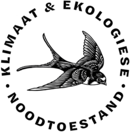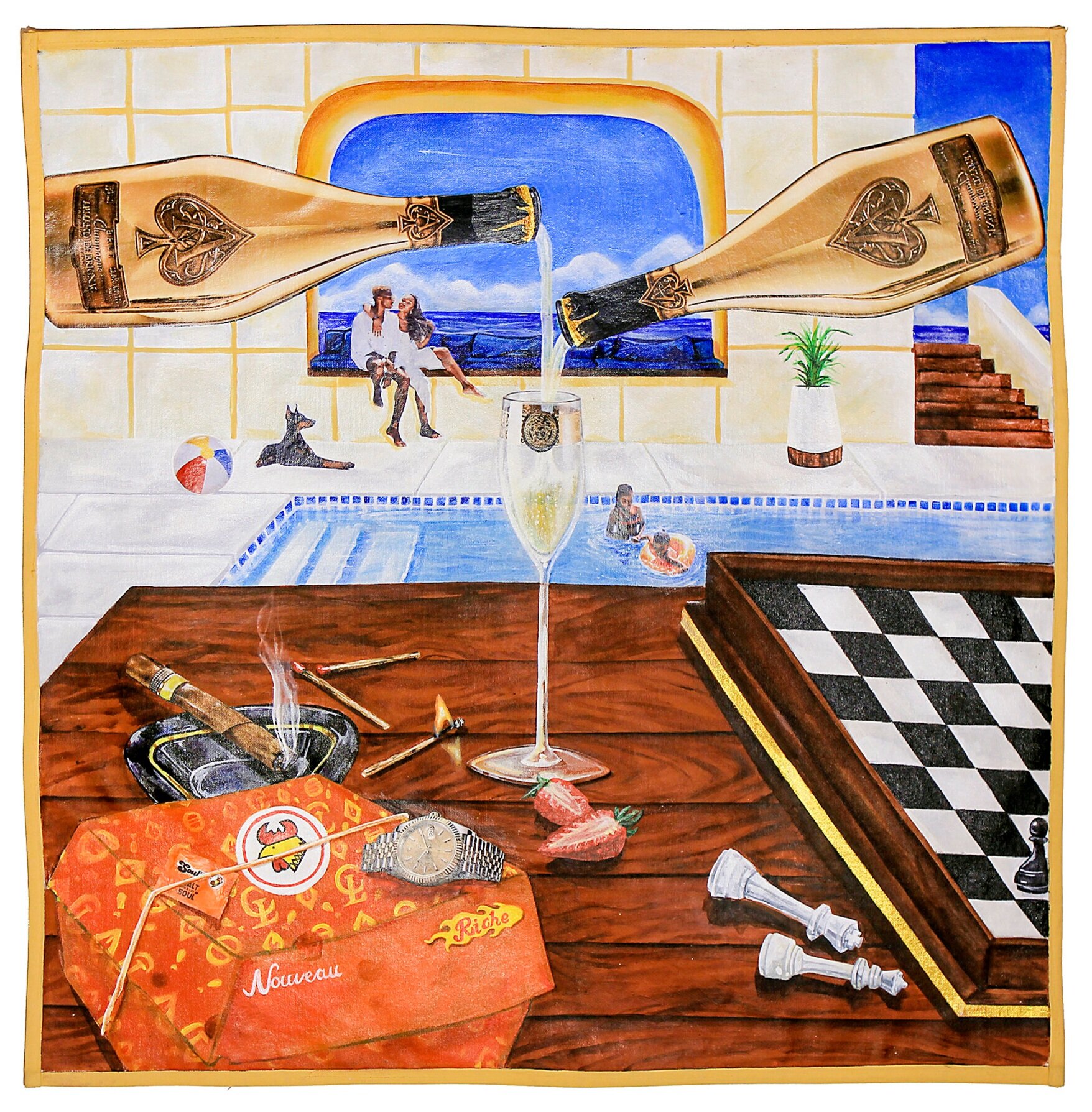Katlego Tlabela en Swart welvaart

Upper East Side, New York (Study), 2020, Akriel, ink en collage op doek, 49.5 x 39.5cm
Midrand, Gauteng (Study), 2020, Akriel, ink en collage op doek, 49.5 x 39.5cm
Ikoyi, Lagos, 2020, Akriel, ink en collage op doek, 49.5 x 39.5cm
Nouveau riche: 'Daar is menswaardigheid in duur klere'
“Die idee van die nouveau riche in die Swart gemeenskap is die kern van my nuwe werk,” vertel Katlego Tlabela, wat ’n BA in Beeldende Kunste aan die Michaelis School of Fine Art verwerf het.
Nouveau Riche is ’n Franse term (dikwels neerhalend) wat diegene beskryf wat hulle welvaart binne hulle eie generasie verkry, eerder as om ryk te erf: new money in plaas van old money (bekend as die vieux riche). As ’n vorm van klassisme verwys die vieux riche na lede van die nouveau riche as die parvenu(’s) – nuwelinge in ’n elite sosio-ekonomiese klas.
“Selfs ná 25 jaar van demokrasie streef die meeste Swart Suid-Afrikaners steeds om hulle eie sosiale en ekonomiese welvaart te skep,” sê Tlabela wat in 1993 in Pretoria gebore is. Volgens die kunstenaar is dit so vir beide hom en sy ouers se generasie.
Tlabela vergelyk die styl van sy kuns met dié van die Amerikaanse kunstenaar Kerry James Marshall, wie se skildery Past Times in 2018 vir ongeveer R270 miljoen verkoop is aan Sean Combs in ’n geskiedkundige transaksie.
“I have accepted that most of what I do will be a statement. This interview for Klyntji, the first and oldest Afrikaans magazine, is a statement.”
Tlabela se kuns word geïnspireer deur lirieke van Afro-Amerikaanse rap en hip-hop. Hy trek ook inspirasie uit Instagram waar die lewens van Suid-Afrika se “black diamonds” uitgebeeld word, soos Bonang Matheba (sy het haar eie sjampanje). Daar is ook Robbie Malinga Jr (Rob Mally), die seun van die ontslape Suid-Afrikaanse musikant Robbie Malinga, wat wel ryk geërf het.
Ons het met die kunstenaar oor sy werk in gesprek getree.
I first became aware of your work through your first solo exhibition, Negro Sunshine, at the NWU Gallery. The exhibition revolved around affirmative statements. Please tell us a bit about the premise of this exhibition.
Negro Sunshine will always have a special place in my heart.
The entry point to the body of work was a series of paintings that re-appropriated texts derived from works titled Warm Broad Glow (2005) and Untitled (2005) by African American multi-disciplinary artist Glenn Ligon which have been created with neon lighting, the words “negro sunshine” illuminate brightly in yellow and black.
The words “negro sunshine” were re-appropriated from Gertrude Stein’s 1909 novella Three Lives in which Stein repeatedly implements the phrase to describe the novella’s main protagonists – which at the time referred to the racist stereotype of the “happy darkie”.
Like Ligon, I have re-appropriated the phrase in order to create an entry point with the sole attempt of stripping away all negative connotations. The texts in the paintings were derived and re-imagined from various sources including Eli Weinberg’s photographic work which depicts a group of protesting women holding up placards which read “We Stand By Our Leaders” during the 1956 Treason Trial in Johannesburg, South Africa.
Negro Sunshine (After Ligon), 2016, Goue skermdruk en emalje op doek, 80 x 60cm
Leaders (After 1956 Treason Trial Protests), 2016, Black pearl-skermdruk en emalje op doek, 80 x 80cm
Negro Sunshine showed at one of the few universities that can still be regarded as Afrikaans, in a town (Potchefstroom) with an overwhelming Afrikaner culture. How did you feel about having the show here, both physically and symbolically?
Thank you to you and De Niro Koffman for organising that exhibition.
It was a breath of fresh air having it at NWU, not only because it’s a predominantly Afrikaans institution, but also because it’s a space that exhibits Standard Bank Young Artist Award exhibitions amongst many other prominent South African exhibitions and festivals. Having a majority of my family there was more important.
Initially, I wanted to exhibit in the main NWU Gallery space, but we are working on that for Nouveau Riche as the aim for it is to be a travelling exhibition. I just hope it’s not an online debut. These works need to be seen in person, but I am willing to wait.
I have accepted that most of what I do will be a statement. This interview for Klyntji, the first and oldest Afrikaans magazine, is a statement.
How does Nouveau Riche, as your second substantial body of work, depart from what you did with Negro Sunshine? Also, which themes are continued?
When I make work, I question each piece and figure if I could make a series of works derived from those ideas. Black Owned Property from Negro Sunshine birthed the ideas for Nouveau Riche.
A central tenet in my new body of work will be unpacking the idea of the nouveau riche in the ever-aspiring Black community. This theme of the Black elite was a sole inspiration for various artworks created throughout my career. However, I never got the chance to explore these ideas as I intend to now.
Throughout the years I have been conducting textual and visual research for these new ideas. These ideas span from sources like South African author and artist Zakes Mda’s novel Black Diamond.
Like in Negro Sunshine, pivotal rap lyrics from African American rap and hip-hop artists like Jay-Z, Nas, Meek Mill and Rick Ross who mostly rap about their rags-to-riches stories play a major role in these ideas and remain a continuous source of inspiration for my previous text-based paintings and prints.
In Nouveau Riche you specifically depict material Black wealth, in a mostly celebratory way. Please tell us more about your thinking behind the exhibition.
My approach for this body of work is not critical per se, but rather celebratory. It begins with an acknowledgment of this new elite but with a focus on the modern-day Black human being. By highlighting these new members of the Black Elite I am creating a world which not only represents the present but also where the viewer and I can prophesise the future.
Is the work also about other forms of wealth, apart from material? If so, what kind?
I recently had a phone call conversation with my stepfather about “bling-bling” and the images of wealth. In our conversation we agreed that jewellery, luxury garments and top of the line alcohol should not be the pinnacle of success, and we should strive for solid family structures, medical aid, smarter funeral plans, security, property, multiple sources of income, generational wealth.
You mention that the ‘Criticism series’ will explore ideas whereby the lifestyles depicting “conspicuous consumption” are questioned. Are you critical of overconsumption and systemic injustices linked to capitalism? Can all be wealthy in equal measure?
Upon conducting my research, I recalled an interview with South African businessman Johann Rupert, who, when interviewed on local news was asked about the maintenance of his familial wealth (old money), mentioned that he does not “buy BMW’s and spend their money on high-end bottles of champagne or on girls in clubs like Taboo and Booth in Sandton.” His statement raises the question whether those of us who are chasing this dream of new money are chasing it in order to build a legacy for our forth-coming generation or whether we are merely living in the moment of posts on Instagram?
“We as Black people, that 70% in poverty, find our dignity in what we put on our backs. We find dignity in the price tags of our clothes. It may seem stupid to the next white person (who may have it all already), but it’s all we got.”
But then again, I am open minded enough to be critical of Rupert’s statement mainly because, like many I love fancy things too, be it a pair of sneakers or cologne. It is not a myth that we love nice things, because that is how we exert our dignity. We as Black people, that 70% in poverty, find our dignity in what we put on our backs. We find dignity in the price tags of our clothes. It may seem stupid to the next white person (who may have it all already), but it’s all we got. Skhotane culture is prime example of that.
Early examples of this stem from childhood when you know that casual / civvies day is a month ahead so you have to tell your parents (in most cases your single parent Mom) in advance that you would like new clothes / have to wear civilian clothes. That in itself was highly unlikely because the only new clothes you’d get would be gifted on Christmas bought with a salary or wage months before. You could only wear them on Christmas and holidays. With that said, we cannot be equally wealthy, that is an unrealistic utopian desire. Unfortunately because of the systemic injustices that are linked to capitalism, we can only strive to be wealthier than the Ruperts. The pie is at the top, and we aren’t invited to the top. We have to set our own table.
To answer your question before I go on a tangent, ‘Criticism Series’ has started in February, but it’s still in progress with a sequel to the Generational Knowledge painting. What I have done is create one or two works from each series, to get a feeling of what to expect, but because I work spontaneously and due to COVID-19, I have not completed much of what I have aimed for.
Where do you see yourself as an artist in ten years? Which collections would you like your work to form part of? Where would you like to exhibit?
It’s difficult to tell, because right now it feels like I am the new kid on the block for the second time. Here’s a list for my genie:
Health
Wealth
Wisdom
Security
Independence
No more creative blocks
I am particularly keen on being in more Black owned collections, whether they are big or small, private or public. I think it’s time for a new dawn of new Black collectors, locally and internationally.
In my triptych painting, Tableau Vivant, Panel 2 and 3 titled Pitori to Paris, pay homage to my hometown of Pretoria/Tshwane. The works envision a retrospective of my earlier works, key works from Negro Sunshine, being installed in one of the world’s leading Art Museums, The Louvre in Paris. This may be the ultimate goal for inclusivity but it does not overlook other museums. I have my eyes on institutions such as Javett Art Centre in Pretoria, Studio Museum in Harlem and Macaal in Marrakech. Lately, I am more interested in institutions and would rather refrain from mentioning commercial galleries as I am still independent and finding who shares my visions.
They will find me when the time is right.
Tableau Vivant, 2020, Akriel, ink, fotokopie-oordrag en collage op doek, 219 x 82cm
Black Owned Property III (Tribute), 2020, Akriel, ink en collage op doek, 86 x 67cm
Bust Study I of III, 2020, Ink en akriel op doek, 71 x 71cm
Bust Study II of III, 2020, Akriel, ink en olie pastel op doek, 700 x 700mm
Our Flute Runneth Over, 2020, Akriel, ink en collage op doek, 74 x 74cm
Generational Knowledge, 2020, Akriel, ink, oliepastel op doek, 72 x 71cm
Eerste en oudste Afrikaanse tydskrif, sedert 1896
Ons bou aan ’n moderne beeld van hoe Afrikaanswees lyk, lees en klink. Het jy van Katlego Tlabela en Swart welvaart gehou? Dan ondersteun ons. Vriende van Klyntji word op hierdie bladsy gelys.














